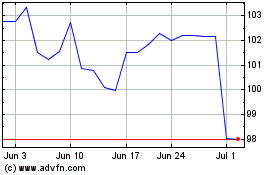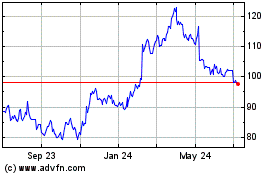Attractions get renamed to make sense in Chinese; Little Flying
Elephant
By Ben Fritz
SHANGHAI -- When Qi Zhu visited Shanghai Disneyland on a day of
testing before the theme park opened last week, she was confused by
its slogan: "Ignite the magical dream within your heart." When
translated into Chinese, those words can easily be read as "strange
dream."
"I was like: 'What is a strange dream?' " says Ms. Qi, a
marketing employee at a Shanghai company. "Why would I want a
strange dream in a park?"
Walt Disney Co. spent more than six years planning every detail
of its new world of princesses, superheroes and swashbuckler Jack
Sparrow, which has cost more than $5.5 billion and is expected to
attract more than 10 million people in its first year.
It hasn't been easy, though, to translate the Disney magic from
English to Chinese. In order to make sense to local visitors and
mesh with their cultural sensibilities, the names of some
attractions at Shanghai Disneyland read very differently in the two
languages posted on signs throughout the theme park.
Because the animated classic "Dumbo" is little-known in China,
the Shanghai Disneyland ride inspired by the movie is Little Flying
Elephant when written in the simplified characters used on the
Chinese mainland. Shipwreck Shore, a play area for children, sounds
more ominous than fun in Chinese, so it is called Ship Water Play
Area instead.
The princess-themed beauty salon known as Bibbidi Bobbidi
Boutique makes no sense in a literal translation to Chinese, so
Disney decided to call it the Colorful Magical Fanciful
Transformation. The Chinese version also has an alliterative "B"
sound.
"Every time we come up with a name, we had to make sure it has a
whimsical Disney feel, it resonates with Chinese people and it
conveys what the experience is," says Fangxing Pitcher, a writer
for the Disney Imagineering theme-park design group. "If you just
do a straight translation, all of that gets lost."
Ms. Pitcher is one of numerous Chinese natives hired to work on
Shanghai Disneyland from its earliest designs. Disney owns 43% of
Shanghai Disney Resort, with the majority controlled by the local
government's Shanghai Shendi Group Co.
Disney also hired as consultants for the new park Chinese
designers, cultural experts and even comedians. In Southern
California, where Disney is based, the company used Chinese
tourists as focus groups while in the early stages of planning
Shanghai Disneyland.
The focus groups showed that instructions that seemed to make
perfect sense in English sometimes didn't register. Words that
sound whimsical and inviting to Western ears were confusing or
off-putting in Chinese.
For its earlier foreign theme parks in Paris and Hong Kong,
Disney did much of the initial design work in English, handling
translation later in the process. Disneyland Paris and Hong Kong
Disneyland, which opened in 1992 and 2005, respectively, struggled
at first to connect with local audiences and have had financial
problems.
In Hong Kong, Chinese visitors sometimes complained that they
couldn't navigate the theme park and didn't know what to do
there.
"We've learned through the years it's always a good idea to be
as accessible to your guests as you can be," says Stan Dodd, an
Imagineering creative director. "I think in previous parks we may
not have thought that through as specifically as we did here."
Getting Chinese translations just right is increasingly
important to Disney. China is the world's second-largest movie box
office, behind only the U.S. "Frozen," the most successful animated
motion picture ever, is loosely translated as "Enchanted Destiny of
Snow." Disney park designers borrowed the name and song
translations for a singalong show at Shanghai Disneyland.
Still, many Chinese names for attractions at the new theme park
had to include literal descriptions because the movie references
that work for Americans fly right over the heads of visitors
here.
Tron Lightcycle Power Run probably doesn't mean much to anyone
who didn't see the 1982 science-fiction movie "Tron" or its 2010
sequel, "Tron: Legacy," featuring neon-colored electronic
motorcycles.
In Chinese, though, Superfast Speed Light Cycle gets across the
point of the thrill ride loud and clear.
Roaring Rapids doesn't quite sound like an adrenaline-charged
adventure when translated literally to Chinese, which is why it is
called Roaring Mountain Rafting Journey.
Disney's theme-park designers in Shanghai realized that coming
up with puns is a particular challenge, since playful misspellings
aren't possible in a pictorial language.
Their solution was to rely on written Chinese characters that
sound the same but have different meanings. Hunny Pot Spin, a
Winnie the Pooh ride, is known here as Spinning Honey Pot, in which
a Chinese character used in the word for "honey" is replaced by the
one meaning "crazy" or "wild."
"People look and they know it's not a very rigid ride, it's
something playful," says Imagineering assistant producer Chang
Xu.
Opinions among the new park's first visitors about the
effectiveness of Chinese names were mixed. Zhang Anzhi, a
Shanghai-born business consultant, said the Fantasyland area was
"boring" because he was so unfamiliar with central characters like
Alice in Wonderland.
Zhao Siyu, who is from Shanghai and attends the University of
North Carolina at Chapel Hill, says she appreciated little touches
such as tombstones in the Pirates of the Caribbean section written
in ancient-style characters.
At last week's grand opening, visitors seemed to care much more
about getting on the most new popular rides than understanding how
much effort went into the surrounding signs.
"I don't have much memory about the translations because I spent
most of the day waiting in line," said Wang Mengmeng, 24 years old,
from Jiangsu province just north of Shanghai.
--Yang Jie and Zhou Wei contributed to this article.
(END) Dow Jones Newswires
June 22, 2016 02:50 ET (06:50 GMT)
Copyright (c) 2016 Dow Jones & Company, Inc.
Walt Disney (NYSE:DIS)
Historical Stock Chart
From Mar 2024 to Apr 2024

Walt Disney (NYSE:DIS)
Historical Stock Chart
From Apr 2023 to Apr 2024
